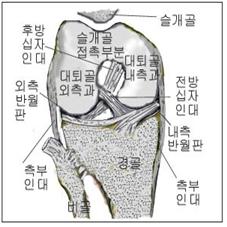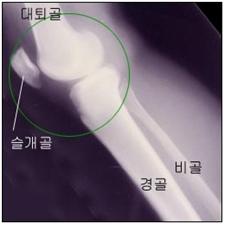전방 십자 인대 단열(슬관절 전방 십자인대 부상/슬관절 전방 십자인대 손상) Anterior cruciate ligament injury of the knee
전방 십자 인대 단열의 개요와 원인
-
무릎관절 속에 전방 십자 인대(Anterior cruciate ligament/ACL)가 있다.(그림 271 참조)
-
8세 이상 학령기 아이들이나 사춘기 아이들의 신체의 모든 계통에 있는 인대들 중 가장 흔히 부상을 입을 수 있는 인대이다.
-
전방 십자 인대를 슬관절 전십자인대, 슬관절 전방 십자인대라고도 한다.
-
거기에 단열손상, 또는 파열 손상이 생길 수 있다.
-
전방 십자 인대 손상을 Anterior cruciate ligament damage(Anterior cruciate ligament tear/ Anterior cruciate ligament injury)라고 한다.
-
그 병명을 전방 십자 인대 단열(Anterior cruciate ligament tear), 전 십자인대 단열, 전방 십자인대 단열, 또는 무릎 전방십자인대 파열이라고 한다.
-
2000년도 미국에서 175,000명 환아가 전방 십자 인대 단열 복구 치료를 받았다.
-
전방 십자 인대 단열을 치료하는데 소요됐던 의료비가 거의 2억불이 되었다.
-
전방 십자 인대 단열은 남성보다 여성에게 훨씬 더 많이 발생된다.
-
특히 여성 운동선수들에게 이 병이 더 잘 생긴다.
- 운동 중 상대 선수와 접촉되지 않고도 전방 십자 인대가 단열될 수 있다.
- 무릎 관절(슬관절)이 과도히 신전되거나, 과도히 외반슬되거나, 또는 과도히 외회전될 때 전방 십자 인대 단열이 생길 수 있다.
-
또 무릎 관절 양쪽 함요 사이의 거리가 짧아도 더 잘 부상될 수 있고
-
호르몬 영향을 받든지,
-
신경근육 이상이 있을 때 전방 십자 인대 부상이 더 잘 발생할 수 있다.
-
전방 십자 인대 단열의 과거 병력이 있는 사람들에게 골성 관절염이 조기에 생기는 경향이 있다.
전방 십자 인대 단열의 증상 징후
-
비 접촉성 운동 중에도 생길 수 있다.
-
그 인대가 단절될 때 맨 귀로도 들을 수 있을 정도로 폽(Pop) 소리가 나고 단절된 무릎이 붓고 아프다.
-
하던 운동을 더 이상 계속 할 수 없는 것이 보통이다.
-
대부분의 경우, 전방 십자 인대 단열이 생겼더라도 어느 정도로 걸을 수 있고 계단을 걸어올라 갈 수도 있고, 자전거를 탈 수도 있고, 경미하게 달릴 수 있다.
전방 십자 인대 단열의 진단
-
병력, 증상 징후, 진찰 소견 등을 종합하고 이 병이 의심되면 무릎 관절 MRI 검사로 진단할 수 있다.
-
AP Drawer 징후, The Lachman 검사와 Pivot 검사 결과로 이 부상을 진단하는데 도움을 얻는다.
전방 십자 인대 단열의 치료
-
무릎관절 고정치료, 수술 치료 등으로 치료한다.
-
그 외 물리치료, 일정한 기간 동안 단열이 생긴 쪽 다리로 운동 하는 것을 정지한다.
-
무릎 관절 속에 응혈이 있으면 수술로 제거하고 비스테로이드제 항 염증제 등으로 대증 치료하고,
- 정상 걸음 회복 운동치료로 치료한다.

그림 271. 무릎 관절 전면 그림 (우)
Copyright ⓒ 2011 John Sangwon Lee, M.D., FAAP

사진 270. ◯내 정상 무릎 관절과 대퇴골, 경골, 비골, 슬개골
Copyright ⓒ 2011 John Sangwon Lee, M.D., FAAP
Anterior cruciate ligament injury of the knee 전방 십자 인대 단열(슬관절 전방 십자인대 부상/슬관절 전방 십자인대 손상)
Overview and Causes of Anterior Cruciate Ligament Insulation
• There is an anterior cruciate ligament/ACL in the knee joint (see Figure 271).
• It is the most commonly injured ligament in all systems of the body in school-age children 8 years of age and older and adolescents.
• The anterior cruciate ligament is also called the anterior cruciate ligament of the knee and the anterior cruciate ligament of the knee.
• There may be insulation damage or rupture damage.
• Anterior cruciate ligament injury is called anterior cruciate ligament damage (Anterior cruciate ligament tear/ Anterior cruciate ligament injury).
• The disease is called anterior cruciate ligament tear, anterior cruciate ligament tear, anterior cruciate ligament tear, or anterior cruciate ligament tear of the knee.
• In 2000, 175,000 children in the United States were treated to repair anterior cruciate ligament insulation.
• Medical expenses to treat anterior cruciate ligament tears have reached nearly $200 million.
• Anterior cruciate ligament tear is much more common in women than men.
• The disease is particularly prevalent in female athletes.
• The anterior cruciate ligament can be insulated without contact with the opponent during exercise.
• Anterior cruciate ligament tear can occur when the knee joint (knee) is overextended, overextended, or overexternally rotated.
• Also, the shorter the distance between the cavities of the knee joint, the more likely it is to be injured. • Whether hormonally affected,
• Anterior cruciate ligament injuries are more likely to occur when there are neuromuscular abnormalities.
• People with a history of anterior cruciate ligament tear tend to develop osteoarthritis early.
Symptoms, signs of anterior cruciate ligament insulation
• It can also occur during non-contact exercise.
• When the ligament is torn, there is a popping sound that can be heard even with the bare ear, and the severed knee is swollen and painful.
• It is normal for you to no longer be able to continue exercising.
• In most cases, even with an anterior cruciate ligament tear, you can walk to some extent, climb stairs, ride a bicycle, and run lightly.
Diagnosis of anterior cruciate ligament tear
• If the disease is suspected after synthesizing the medical history, symptom signs, and examination findings, it can be diagnosed with an MRI of the knee joint.
• AP Drawer signs, The Lachman test, and Pivot test results are helpful in diagnosing this injury.
Treatment of anterior cruciate ligament insulation
• It is treated with knee joint fixation treatment and surgical treatment.
• Other physical therapy, stop exercising with the insulated leg for a certain period of time.
• If there is a blood clot in the knee joint, remove it surgically and treat symptomatically with non-steroidal anti-inflammatory drugs, etc.
• Treat with normal gait recovery exercise therapy.

Figure 271. Anterior view of the knee joint (right) Copyright ⓒ 2011 John Sangwon Lee, M.D., FAAP

Picture 270. ◯My normal knee joint and femur, tibia, fibula, and patella Copyright ⓒ 2011 John Sangwon Lee, M.D., FAAP
출처 및 참조 문헌 Sources and references
- NelsonTextbook of Pediatrics 22ND Ed
- The Harriet Lane Handbook 22ND Ed
- Growth and development of the children
- Red Book 32nd Ed 2021-2024
- Neonatal Resuscitation, American Academy Pediatrics
- www.drleepediatrics.com 제16권 소아청소년 정형외과 질환
- www.drleepediatrics.com제8권 소아청소년 호흡기 질환
- www.drleepediatrics.com제9권 소아청소년 소화기 질환
- www.drleepediatrics.com제10권. 소아청소년 신장 비뇨 생식기 질환
- www.drleepediatrics.com제11권. 소아청소년 심장 혈관계 질환
- www.drleepediatrics.com제12권. 소아청소년 신경 정신 질환, 행동 수면 문제
- www.drleepediatrics.com제13권. 소아청소년 혈액, 림프, 종양 질환
- www.drleepediatrics.com제14권. 소아청소년 내분비, 유전, 염색체, 대사, 희귀병
- www.drleepediatrics.com제15권. 소아청소년 알레르기, 자가 면역질환
- Red book 29th-31st edition 2021
- Nelson Text Book of Pediatrics 19th — 21st Edition
- The Johns Hopkins Hospital, The Harriet Lane Handbook, 22nd edition
-
Childhood Emergencies in the Office, Hospital and Community, American Academy of Pediatrics
-
Emergency Medical Service for Children, By Ross Lab. May 1989. p.10
-
Emergency care, Harvey grant, and Robert Murray
-
Emergency Care Transportation of Sick and Injured American Academy of Orthopaedic Surgeons
-
Emergency Pediatrics A Guide to Ambulatory Care, Roger M. Barkin, Peter Rosen
-
Immediate care of the acutely ill and injured, Hugh E. Stephenson, Jr
-
The Critically Ill Child, Diagnosis and Management, Edited by Clement A. Smith
-
Emergency Medical Services for Children: The Role of the Primary Care Provider, America Academy of Pediatrics
-
Quick Reference To Pediatric Emergencies, Delmer J. Pascoe, M.D., Moses Grossman, M.D. with 26 contributors
-
Manual of Emergency Care 응
-
급환자관리 정담미디어
-
소아가정간호백과–부모도 반의사가 되어야 한다, 이상원
-
Neonatal Resuscitation American heart Association
-
Neonatology Jeffrey J.Pomerance, C. Joan Richardson
-
Pediatric Resuscitation Pediatric Clinics of North America, Stephen M. Schexnayder, M.D.
-
Pediatric Critical Care, Pediatric Clinics of North America, James P. Orlowski, M.D.
-
Preparation for Birth. Beverly Savage and Dianna Smith
- Infectious disease of children, Saul Krugman, Samuel L Katz, Ann A. Gershon, Catherine Wilfert
-
The Harriet Lane Handbook 19th Edition
-
소아과학 대한교과서
-
제1권 소아청소년 응급의료 참조문헌과 출처
-
Other
Copyright ⓒ 2015 John Sangwon Lee, MD., FAAP
“부모도 반의사가 되어야 한다”-내용은 여러분들의 의사로부터 얻은 정보와 진료를 대신할 수 없습니다.
“The information contained in this publication should not be used as a substitute for the medical care and advice of your doctor. There may be variations in treatment that your doctor may recommend based on individual facts and circumstances. “Parental education is the best medicine.”